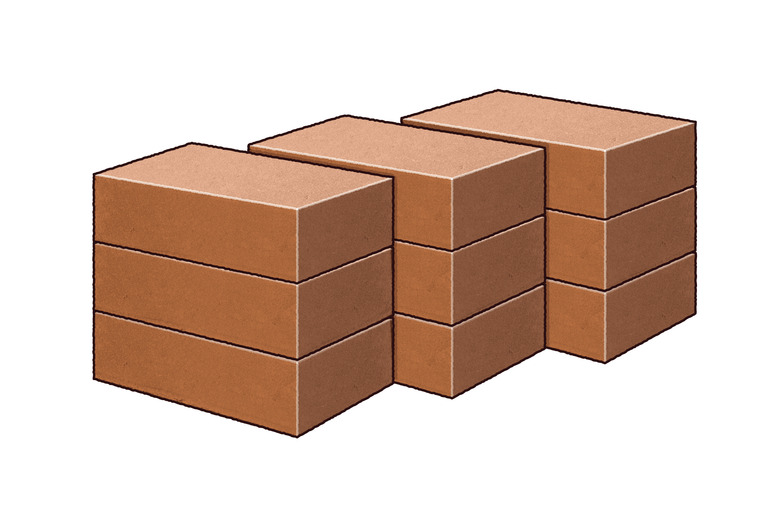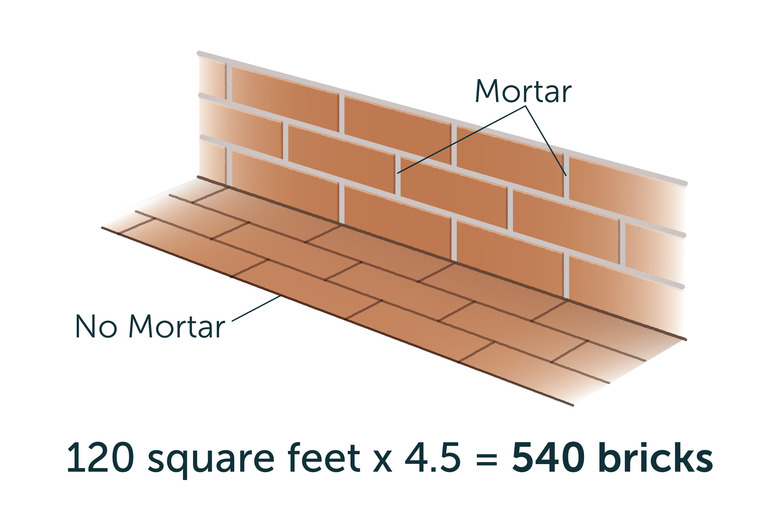How To Calculate Number Of Bricks Per Square Foot
If you're planning a project involving bricks or pavers, you'll probably need to have them delivered, so you'll have to measure the dimensions of the planned installation and calculate how many you need. To answer the question: how many bricks in a square foot, you have to decide on the size of the bricks you want to use (the same goes for pavers) and whether or not you're going to use mortar. Of course, mortar is required if you're building a structural brick wall, but if you're building a small garden wall or you're laying pavers, it may not be necessary.
Here's all you need to know to calculate how many bricks in a square foot for any brick size.
Brick Sizes
Bricks and pavers are building materials that come in different sizes, but there are two standard sizes for each: one that takes into account a mortar joint and one that doesn't. The most common mortar joint is 3/8 inch, but a 1/2-inch joint is also used in brickwork. Modular bricks and pavers are manufactured for use with mortar and are slightly smaller than standard, or nonmodular, bricks. Module brick are sized to make their dimensions measure out in whole numbers when the thickness of the mortar joint is taken into account.
When calculating how many bricks in a square foot (or how many pavers), it doesn't matter whether you use modular or nonmodular ones. The final dimensions of modular bricks include the mortar joint and come out to be the same as non-modular ones, so the number of bricks stays roughly the same. When using modular brick without mortar, the number of bricks is slightly greater than when using nonmodular bricks without mortar.
Determining How Many Bricks In a Square Foot
You'll need to measure the square footage of the wall, patio, or whatever else you want to build and divide that by the number of bricks per square foot, but before you do that, you need to consider a few things.
Brick and Paver Dimensions
Brick comes in many sizes, not just the standard ones, and the size of the brick obviously affects how many can fit in a given area. Besides the standard-size brick, there are such sizes as jumbo modular and nonmodular, queen, Norman, and monarch. In addition, some bricks are half the thickness of others; the same is true for pavers.
You don't always have to perform the calculations for the number of bricks per square foot yourself because many suppliers provide a brick calculator on their website. It's good to know what's out there, though, so here are tables that show some of the common brick and paver dimensions (in inches) used in the United States. (Dimensions and names of types vary by country.)
Brick Types and Sizes
|
Brick Type |
Size in Inches (Width x Thickness x Length) |
Number Per Sq. Ft. (3/8-Inch Mortar Joint) |
Modular Brick Equivalent |
|
Modular |
3 5/8 x 2 1/4 x 7 5/8 |
6.86 |
1 |
|
Standard Nonmodular |
3 5/8 x 2 1/4 x 8 |
6.55 |
1.05 |
|
Jumbo Modular |
3 5/8 x 2 3/4 x 7 5/8 |
5.76 |
1.22 |
|
Jumbo Standard |
3 5/8 x 2 5/8 x 8 |
5.73 |
1.22 |
|
Queen |
3 1/8 x 2 3/4 x 9 5/8 |
4.61 |
1.54 |
|
Roman |
3 5/8 x 1 5/8 x 11 5/8 |
6.00 |
1.10 |
|
Norman |
3 5/8 x 2 1/4 x 11 5/8 |
4.57 |
1.52 |
|
Jumbo Norman |
3 5/8 x 2 3/4 x 11 5/8 |
3.84 |
1.86 |
|
Ambassador |
3 5/8 x 2 1/4 x 15 5/8 |
3.43 |
2.05 |
|
Modular Economy |
3 5/8 x 3 5/8 x 7 5/8 |
4.50 |
1.61 |
|
Utility |
3 5/8 x 3 5/8 x 11 5/8 |
3.00 |
2.45 |
|
Monarch |
3 5/8 x 3 5/8 x 15 5/8 |
2.25 |
3.30 |
|
Double Monarch |
3 5/8 x 7 5/8 x 15 5/8 |
1.13 |
6.94 |
|
Quad |
3 5/8 x 7 5/8 x 7 5/8 |
2.25 |
3.39 |
Brick Paver Types and Sizes
|
Paver Type |
Size in Inches (Width x Thickness x Length) |
Number Per Sq. Ft. |
|
Split Paver |
3 5/8 x 1 1/8 x 7 5/8 |
5.21 |
|
Modular Paver |
3 5/8 x 2 1/4 x 7 5/8 |
5.21 |
|
Standard Paver |
4 x 2 1/4 x 8 |
4.50 |
|
Standard ADA Domed Paver |
4 x 2 1/4 x 8 |
4.50 |
|
Standard 8 x 8 Paver |
8 x 2 1/4 x 8 |
2.25 |
|
Jumbo Paver |
4 x 2 3/4 x 8 |
4.50 |
|
Jumbo Permeable Paver |
4 x 2 3/4 x 8 |
4.50 |
|
Standard Plank Paver, Flat Set |
4 x 2 1/4 x 12 |
3.00 |
|
Standard Plank Paver, Edge Set |
2 1/4 x 4 x 12 |
5.33 |
|
Jumbo Plank Paver, Flat Set |
4 x 2 3/4 x 12 |
3.00 |
|
Jumbo Plank Paver, Edge Set |
2 3/4 x 4 x 12 |
4.36 |
The most common way to lay bricks is end to end on their face with the middle of each brick in one row intersecting the joint of two bricks in the row underneath, but this is by no means the only orientation possible. Sometimes, bricks are laid on edge or with one end facing out. Orientation affects the brick dimensions as seen from the front of the structure, and it affects the total number of bricks that will fit in a square foot. Bricklayers give these orientations special names:
- Stretcher: The long side of the brick faces you, and the brick lays on its face. This is probably the most common orientation.
- Shiner: This is the same as a stretcher, but the brick rests on its edge.
- Header: The end of the brick faces you, and the brick lays on its face.
- Rowlock: The end of the brick faces you, and the brick rests on its edge.
- Soldier: The brick stands on end with the narrow side facing you.
- Sailor: The brick stands on end with the wide side facing you.
A brick wall is often constructed with double rows of bricks, and headers are interspersed with stretchers to make the structure stronger. This type of 8-inch brick wall is called a one-brick wall, as opposed to a half-brick wall, which consists only of a single layer of bricks and is 4 inches thick.
Sample Brick Calculations
If you're using bricks with nonstandard sizes, it's best to consult the brick calculator on your supplier's website to find the number you need based on the area or volume of the structure. It is possible to make these calculations yourself, though, assuming all the bricks you use are the same size and, if you're building a wall, most of them are stretchers.
Calculating Bricks for a Half-Brick Wall
When constructing a half-brick wall, you start with the total area of the wall in square feet and divide that by the square-foot value of a single brick.
- Measure the wall length and wall height in feet and multiply these numbers to get the total area.
- Measure the length and thickness of a single brick in inches and multiply to get the exposed area of the brick in square inches. (If you're calculating pavers, you measure the length and width of the paver to get the area).
- Multiply the area of a single brick or paver by 0.007 to convert to square feet.
- Divide the area of a single brick into the wall area to determine the quantity of bricks or pavers you need.
Brick pavers are typically laid flat, with their faces up, so your calculation is based on the face area of the brick. In most DIY patio or walkway projects, the bricks are not mortared and are simply laid so they touch one another on all sides (then the seams are filled with sand). In this case, use the actual dimensions of the brick face for your calculations.
When constructing a one-brick wall, it's most efficient to calculate the total volume of the wall in cubic feet and divide by the volume of a single brick (which has to be converted from cubic inches to cubic feet).
- Measure the length and width of the wall in feet. Multiply these numbers to find the area.
- Measure the thickness of the wall in inches. Convert this number to feet by dividing it by 12.
- Multiply the area by the thickness to find the volume of the wall in cubic feet.
- Measure the length, width, and thickness of a single brick. You have to take the thickness of the mortar joint into account, but if you're using standard modular bricks and a 3/8-inch joint, you can use 4 inches for the width, 8 inches for the length, and 2 1/4 inches for the thickness. Multiply the dimensions to get the volume of one brick in cubic inches, then multiply by 0.00058 to convert to cubic feet.
- Divide the volume of a single brick into the total wall volume to find the number of bricks you need.



